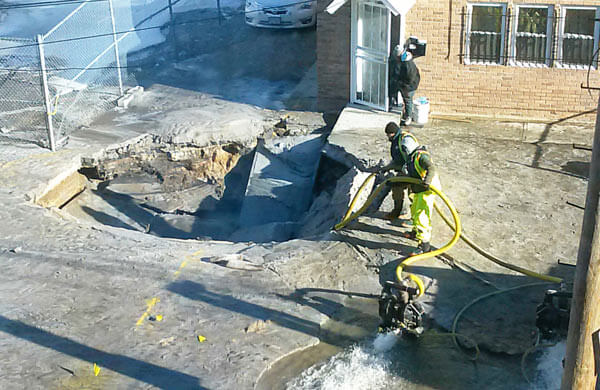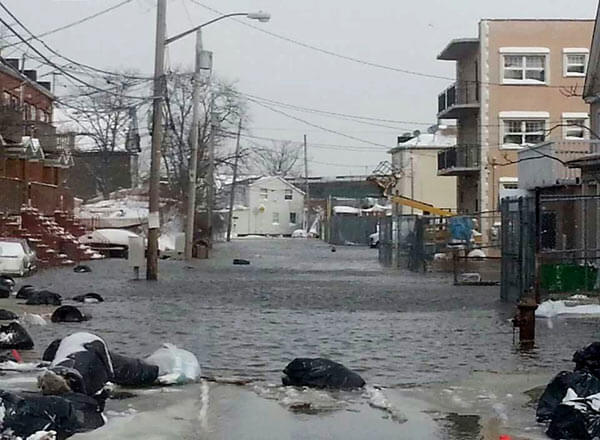By Kerlern Rae Tuitt
Flooding has plagued Rockaways residents of Beach 84th Street and Beach Channel Drive for years, but the long-term effects have made sinkholes a dangerous new problem for families living there.
Marissa Bernowitz, relief site coordinator for the Rockaway’s Free Flea Market, said the floods have been an issue as long as she has “been alive.”
“Every time it rains it floods, and people are walking in raw sewage,” Bernowitz said.
Water is more likely to flow into the area because the intersection sits lower than the areas that surround it, said Community Board 14 District Manager Jonathan Gaska, who pointed out that the storm sewers were also not functioning properly.
“We requested they be repaired. It’s an ongoing capital sewer project,” he said.
Gaska said the completed sewer project should provide some relief, but it is not scheduled to be finished until the end of spring.
As a result of the flooding, residents have had to deal with damaged houses and the risk of new holes opening up. Families are also faced with the threat of injury if someone were to fall into one of the holes. So far, no one has been hurt.
“There are many young children living in these homes, and they can’t get to school sometimes or get out under these conditions should an emergency arise,” said Brett Scudder, 40, of Rockaway Beach.
Scudder and his family used to live on Beach 69th Street before they lost their home in Hurricane Sandy. They found a new house on Beach 84th Street about three months ago, and since they moved in, Scudder has reported multiple incidents of flooding to the area’s City Council members and the city Department of Environmental Protection. Scudder also said the sinkholes have grown in size.
“As far as the collapses, that’s what happens when the ground gets inundated by water — it gets weak under it,” Gaska said.
Gaska said the flooding and the sinkholes stem from different things, including the effects of Hurricane Sandy.
“That whole area was under 5 to 6 feet of water, so we’re getting reports every now and then in different neighborhoods in Rockaway of various sinkholes opening up,” Gaska said.
The block flooded again last week when a water main broke, and according to Bernowitz, at least two families lost heat after their boiler systems went out. The city DEP fixed the break and closed the hole.
“It’s very hard to deal with when a water main or anything like that breaks — no one anticipates it,” said Councilman Donovan Richards (D-Laurelton), who contacted the commissioner’s office and had emergency responders sent in despite it being outside his district.
Scudder said the community was grateful to the councilmen and emergency services for acting quickly, but said there is still no resolution to the underlying problem.
“This is not the first or the second or the third time it’s happened. We were not aware that there were so many problems. The landlord did not mention any of this,” Scudder said.
Despite the efforts of the DEP, Scudder said the sinkhole has resurfaced and there has been more flooding since the water main incident.
“The flooding is going to continue to happen. They’re not going to raise the streets high enough to be able to avoid the flooding, and for people to continue living in that situation is not good,” Scudder said.
Richards said anytime people live near the beach or the bay, they are going to have flood issues, and these Rockaway residents live about a block from the bay. He also said the bay caused more damage to the Rockaways than the beach did, and he is working to get state funds for bay restoration.
“We’re more interested in a long-term solution at this point. The city, the state — everyone is going to have to play a role here in making sure that protection is put in,” Richards said.
Chris Gardner, spokesman for the U.S. Army Corps of Engineers, said a reformulation study is still in effect concerning more concrete Rockaways restoration projects.
“As far as a new project for the bayside, that’s something we would have to study different alternatives for and find something to move forward with,” Gardner said.
Bernowitz said the conditions on the block have forced some residents to sell, abandon or move out of their homes. Families are planning a homeowners’ meeting to discuss their options, including possibly leaving the area.
“It’s obviously not safe — the whole street is under sea level. Sandy victims are being victimized all over again,” Bernowitz said.

































